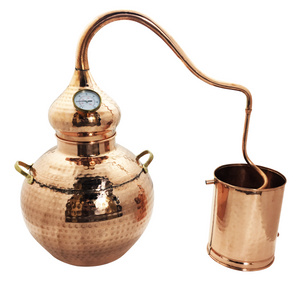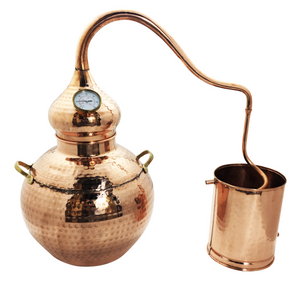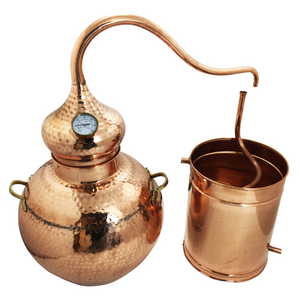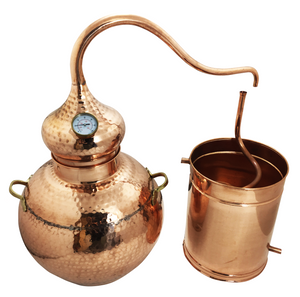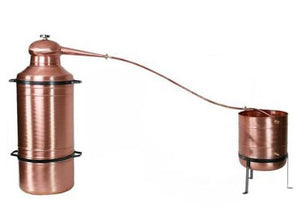Featured Products
2.5 Gallon Moonshine Still
5 Gallon Moonshine Still
10 Gallon Moonshine Still
15 Gallon Moonshine Still
19 Gallon Moonshine Still
The Moonshine Still
If you have made it to this web site, then you probably realize that "moonshine" doesn't refer to any specific type of distilled spirit. Most moonshine recipes call for ground or flaked corn, malted barley, and sugar, but part of the appeal of moonshining is that there aren't really any rules. If a distiller is willing to take the time to experiment and learn, virtually any fruit or grain can be fermented and distilled into an alcoholic beverage of better than average quality.
Moonshine Still Co. stills are copper pot stills and can be used to make traditional types of moonshine, but they may also be used to make several other kinds of distilled alcoholic beverages, including other kinds of whiskey, gin, brandy, vodka, or rum. Other kinds of stills include reflux stills, column stills, and alembic stills, and some commentators further divide pot stills into the categories of moonshine stills and artisan pot stills. In this sort of taxonomy, Moonshine Stills Co. stills are moonshine stills.
Compared to some other kinds of stills, a pot still allows more of the other compounds (other than pure alcohol) in an alcoholic mixture, called congeners, to make their way through the condenser and into the end product. These impurities cause the distilled spirit to retain some of the characteristics of the ingredients that are used to make it. Other kinds of stills, such as a reflux still, do a very good job at separating the alcohol from a wash and creating a purer, more neutral tasting alcoholic drink. But not everyone distills alcohol because he wants to separate all of the alcohol from everything else in the wash. Many craft distillers or artisans want the product to retain the better characteristics of ingredients they've included in the mash. And even if you just want to make a batch of very pure alcohol with a pot still, you still have the option of distilling multiple times to increase the purity.
Getting Started Distilling
If web traffic is any indication, tens of thousands of people are interested in distilling their own alcohol, but most never seem to manage to get the ball rolling. Probably part of the reason that so few explore their interest is that sources of basic information are difficult to locate. Resources for experienced distillers seem to be everywhere, but when beginners access these, they end up confused and daunted by unfamiliar terms and complex technical information.
The most important things to understand when you're getting started is that the fundamentals of making distilled spirits are not that complex, and that people far less sophisticated than you were doing this with more unwieldy tools nearly a thousand years ago. Do you think the Italians understood pH or sparging in the Middle Ages? Of course they didn't, but they knew how to party.
So in basic terms, creating a distilled spirit is a two stage process: 1) Fermentation & 2) Distillation. Fermentation happens when microorganisms, usually yeasts, metabolize (convert) sugars into alcohol and carbon dioxide. When sugars from grain (corn, wheat, barley, rye) are converted by yeast into alcohol and carbon dioxide, we get beer. When the sugars from fruit (grapes, cherries, plums, peaches…) are converted to alcohol and carbon dioxide, we get wine. Beer is the pre-distilled form of whiskey and can also be the basis for vodka and gin. Wine is the pre-distilled form of brandy or cognac. So if you know how to make beer or wine, you're only one simple step away from distilling spirits. And even if you don't, directions are available on our site.
Distillation is the process of attempting to separate the alcohol in an alcoholic drink from everything else. The form of alcohol that we enjoy in drinks is ethanol, and it boils and begins to turn to vapor at 173.1 degrees. Water, on the other hand, boils at 212 degrees. So by slowly heating a mixture that contains alcohol and water (such as beer or wine), it is possible to vaporize the ethanol while leaving most of the water in the liquid state. When ethanol is vaporized, it floats up and away from the liquid mixture. A distillation apparatus or still then cools this vapor, causing it to re-condense (turn back into liquid) and lets it run out into a container.
This simple understanding is all you need to get started. As you can probably guess, making great liquor takes some practice, but the process of learning about distilling will be one of the more entertaining lessons you'll ever receive. And even if the first few things you make aren't your best, knowing that you made them yourself will make your concoctions easy to swallow. To help get you going, we offer a free moonshine guide & recipe. Feel free to browse our FAQ or email with questions. Happy distilling!




